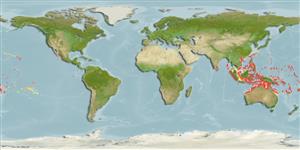Issue
The synonym P. quadrispinosa (Weber, 1913) is valid and redescriberd according to Johnson & White, 2012 (Ref. 90268).
Environment: milieu / climate zone / depth range / distribution range
Ecology
Marine; reef-associated; depth range 0 - 100 m (Ref. 128797). Tropical; 30°N - 24°S
Indo-West Pacific: India and Sri Lanka to Tonga (Ref. 53797); , Ryukyu Islands and the Great Barrier Reef to the Marshall Islands and Samoa.
Size / Weight / Age
Maturity: Lm ? range ? - ? cm
Max length : 24.0 cm TL male/unsexed; (Ref. 48636)
Dorsal spines (total): 4 - 5; Dorsal soft rays (total): 20 - 21; Anal spines: 1; Anal soft rays: 17. A row of small blackish spots in outer third of anal fin (Ref 42740). Males develop a conspicuous ocellus on each side of the nape (Ref. 1602). Young are best identified by the patch of small spots on the cheek that usually remains evident in adults (Ref. 48636).
Body shape (shape guide): elongated; Cross section: oval.
Inhabits both clear lagoon and seaward reefs, in areas of open sand and rubble as well as on rocky surfaces between coral heads. Also in current prone channels (Ref. 48636). May be found solitary or form small groups (Ref. 90102).
Life cycle and mating behavior
Maturity | Reproduction | Spawning | Eggs | Fecundity | Larvae
Randall, J.E., G.R. Allen and R.C. Steene, 1990. Fishes of the Great Barrier Reef and Coral Sea. University of Hawaii Press, Honolulu, Hawaii. 506 p. (Ref. 2334)
IUCN Red List Status (Ref. 130435: Version 2025-1)
Threat to humans
Harmless
Human uses
Tools
Special reports
Download XML
Internet sources
Estimates based on models
Preferred temperature (Ref.
123201): 26.1 - 29, mean 28 °C (based on 586 cells).
Phylogenetic diversity index (Ref.
82804): PD
50 = 0.5000 [Uniqueness, from 0.5 = low to 2.0 = high].
Bayesian length-weight: a=0.00692 (0.00314 - 0.01524), b=3.06 (2.88 - 3.24), in cm total length, based on LWR estimates for this Genus-body shape (Ref.
93245).
Trophic level (Ref.
69278): 3.6 ±0.4 se; based on size and trophs of closest relatives
Generation time: 1.4 ( na - na) years. Estimated as median ln(3)/K based on 1
growth studies.
Resilience (Ref.
120179): High, minimum population doubling time less than 15 months (Preliminary K or Fecundity.).
Fishing Vulnerability (Ref.
59153): Low vulnerability (18 of 100).
🛈
Nutrients (Ref.
124155): Calcium = 87.2 [47.6, 133.7] mg/100g; Iron = 0.685 [0.432, 1.101] mg/100g; Protein = 18.2 [15.9, 20.1] %; Omega3 = 0.0982 [, ] g/100g; Selenium = 36.4 [19.8, 69.6] μg/100g; VitaminA = 70.1 [25.2, 189.7] μg/100g; Zinc = 1.4 [1.0, 2.0] mg/100g (wet weight);
